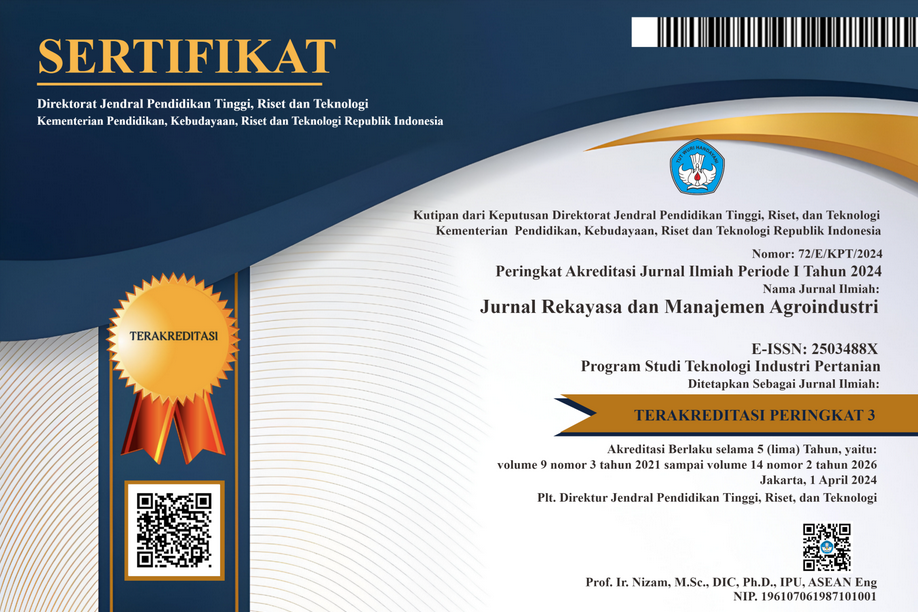Pengaruh Rasio Campuran Surfaktan dan Rasio Campuran Surfaktan dengan Minyak Atsiri Cempaka Putih (Michelia alba DC.) Terhadap Karakteristik Mikroemulsi Sebagai Body Mist
Abstract
Essential oils are complex mixtures of volatile alcohol compounds and are produced as secondary metabolites in plants. Essential oils usually determine the characteristic aroma of the plant, white cempaka flowers contain 0.2 % essential oil obtained by distillation. The essential oil contained in white cempaka is shown to have antimicrobial activity. This study aims to determine the effect of the formulation of the ratio of the surfactant mixture Tween 80: Tween 20: Span 80 on the microemulsion characteristics of white cempaka essential oil as a body mist, determine the ratio of the surfactant mixture Tween 80 : Tween 20: Span 80 appropriately to obtain the microemulsion characteristics of white cempaka essential oil as a body mist, knowing the effect of the ratio of the mixture of surfactants and essential oil of white cempaka on the microemulsion characteristics of white cempaka essential oil as a body mist and determining the appropriate ratio of the mixture of white cempaka and essential oil to obtain the microemulsion characteristics of white cempaka essential oil as body mist . This experiment used a one-factor Complete Randomized Design (RAL). In this study, it was carried out in 2 stages. The first stage consists of a ratio of 20:80 tween surfactant mixtures: 80: span 80 with 5 levels, namely (97:2,27:0.25); (97:2,5:0,5); (97:2,25:0,75); (97:2:1) and (97:1,75:1,25) The second stage consists of a mixture of surfactants: white cempaka essential oil selected in the first stage consisting of 11 levels, namely (90:10) (87,5:12,5) (85:15) (82,5:17,5) (80:20) (77,5:22,5) (75:25) (72,5:27.5) (70:30) (67,5:32,5) (65:35). Stability tests were performed against centrifugation, pH and 8-week intermittent dilution with turbidity index parameters the turbidity index test was performed every 2 weeks, the damage rate was calculated using linear regression analysis. Turbidity index values below 1% and transparent appearance are expressed as stable microemulsions. The results showed that the ratio of nonionic surfactant mixtures of Tween 80, Tween20, Span80 at RS5 treatment (1.75,97,1.25) was the best result with the characteristics of the turbidity index value before testing, namely 0.241±0.020, after centrifugation 0.253±0.026. Meanwhile, the ratio of a mixture of surfactants and white cempaka essential oil in the SM6 treatment of 77.5: 22.5 was the best result with a transparent appearance, the turbidity index value before the test was 0.464±0.077 and after centrifugation 0.211±0.002. The best microemulsions are microemulsions that have the highest concentration of white cempaka oil. The microemulsion of white cempaka essential oil is stable against dilution using pH 4.5, pH 5.5, pH 6.5 and dilutions of 1:9, 1:49, and 1:99 during 8 weeks of storage. The size of the microemulsion droplets of white cempaka essential oil with an average of 40.0±24.0 nm with a polydispersion index value of 0.333. The microemulsion of white cempaka essential oil has an average potential zeta value of -1.2 and is stable for 8 weeks of storage.
Keywords :Mikroemulsi, rasio, surfaktan, Michelia alba DC.
Penelitian ini bertujuan untuk mengetahui pengaruh rasio campuran surfaktan Tween 80:Tween 20:Span 80 terhadap karakteristik mikroemulsi minyak atsiri cempaka putih (Michelia Alba Dc.) sebagai body mist serta menentukan rasio campuran surfaktan Tween 80:Tween 20:Span 80 yang tepat untuk memperoleh karakteristik mikroemulsi minyak atsiri cempaka putih sebagai body mist dan menentukan rasio campuran surfaktan dan minyak atsiri cempaka putih yang tepat untuk memperoleh karakteristik mikroemulsi minyak atsiri cempaka putih sebagai body mist. Percobaan ini menggunakan Rancangan Acak Lengkap (RAL) satu factor. Pada penelitian ini dilaksanakan dalam 2 tahap. Tahap pertama terdiri dari rasio campuran surfaktan tween 20: tween 80: span 80 dengan 5 taraf yaitu (97:2,27:0,25); (97:2,5:0,5); (97:2,25:0,75); (97:2:1) dan (97:1,75:1,25) Tahap kedua terdiri dari rasio campuran surfaktan: minyak atsiri cempaka putih yang terpilih pada tahap pertama yang terdiri dari 11 taraf yaitu (90:10) (87,5:12,5) (85:15) (82,5:17,5) (80:20) (77,5:22,5) (75:25) (72,5:27,5) (70:30) (67,5:32,5) (65:35). Uji stabilitas dilakukan terhadap gaya sentrifugasi, pH dan pengenceran sela ma 8 minggu dengan parameter indeks turbiditas pengujian indeks turbiditas dilakukan setiap 2 minggu, laju kerusakan dihitung menggunakan analisis regresi linier. Nilai indeks turbiditas dibawah 1% dan kenampakan transparan dinyatakan sebagai mikroemulsi yang stabil. Hasil penelitian menunjukan bahwa rasio campuran surfaktan nonionik Tween 80, Tween20, Span80 pada perlakuan RS5 (1,75,97,1,25) merupakan hasil terbaik dengan karakteristik nilai indeks turbiditas sebelum pengujian yaitu 0,241±0,020, sesudah sentrifugasi 0,253±0,026. Sedangkan, rasio campuran surfaktan dan minyak atsiri cempaka putih pada perlakuan SM6 77,5: 22,5 merupakan hasil terbaik dengan kenampakan transparan, nilai indeks turbidias sebelum pengujian 0,464±0,077 dan sesudah sentrifugasi 0,211±0,002. Mikroemulsi terbaik yaitu mikroemulsi yang memiliki konsentrasi minyak cempaka putih tertinggi. Mikroemulsi minyak atsiri cempaka putih stabil terhadap pengenceran menggunakan pH 4,5, pH 5,5, pH 6,5 dan pengenceran 1:9, 1:49, dan 1:99 selama penyimpanan 8 minggu. Ukuran droplet mikroemulsi minyak atsiri cempaka putih dengan rata-rata yaitu 40,0±24,0 nm dengan nilai indeks polidispersi yaitu 0,333. Mikroemulsi minyak atsiri cempaka putih memiliki nilai zeta potensial rata-rata yaitu -1,2 dan stabil selama 8 minggu penyimpanan.
Kata kunci : Mikroemulsi, rasio, surfaktan, Michelia alba DC
Downloads
References
Amar, I., Aserin, A.,dan Garti, N. (2002). Solubilization patterns of lutein and lutein esters in food grade nonionic microemulsions. Journal of Agricultural and Food Chemistry, 51, 4775-4781. https://doi.org/10.1021/jf026222t
Daud, M. K., Nafees, M., Ali, S., Rizwan, M., Bajwa, R. A., Shakoor, M. B., dan Zhu, S. J. (2017). Drinking water quality status and contamination in Pakistan. BioMed research international. https://doi.org/10.1155/2017/7908183
Dizaj, S.M. (2013). Preparation and study of vitamin A palmitate microemulsion drug delivery system and investigation of co-surfactant effect. Journal of Nanostructure in Chemistry, 3(1), 1-6. https://doi.org/10.1186/2193-8865-3-59
Elfiyani, R., Amalia, dan A.,Septian, Y. P. (2017). Effect of using the combination of tween 80 and ethanol on the forming and physical stability of microemulsion of eucalyptus oil as antibacterial. Journal of young pharmacists, 9(1), s1-s4. https://doi.org/10.5530/jyp.2017.1s.1
Fitriani, E. W., E. Imelda, C. Kornelis., dan C. Avanti. (2016). Karakterisasi dan stabilitas fisik mikroemulsi tipe A/M dengan berbagai fase minyak. Pharmaceutical Sciences and Research (Psr). 3(1), 31-44. https://doi.org/10.7454/psr.v3i1.3221
Flanagan, J. Singh, H. (2006). Microemulsions: a potential delivery system for bioactive in food. Critical Reviews in Food Science and Nutrition 4, 221-237. https://doi.org/10.1080/10408690590956710
Hasrawati A, Hasyim N., dan Irsyad NA. (2016). Pengembangan formulasi mikroemulsi minyak sereh (Cymbopogon nardus) menggunakan emulgator surfaktan nonionic. 3(1), 151-154. https://doi.org/10.33096/jffi.v3i1.176
Harborne, J. B. (1987). Chemical signals in the ecosystem. Annals of Botany 60, 39-57. https://doi.org/10.1093/oxfordjournals.aob.a087517
Iswara, F. P., Rubiyanto, D., dan Julianto, T. S. (2014). Analisis senyawa berbahaya dalam parfum dengan kromatografi gas-spektrometri massa berdasarkan material safety data sheet (Msds). Indonesian Journal of Chemical Research, 1(2), 18-27. https://doi.org/10.20885/ijcr.vol1.iss2.art3
Indirasvari, Natalie K. S., I. D. G. Mayun Permana., dan I.K Suter. (2018). Stabilitas mikroemulsi vco dalam air pada variasi hlb dari tiga surfaktan selama penyimpanan. Jurnal Ilmu dan Teknologi Pangan Vol. 7 (4),184-191. https://doi.org/10.24843/itepa.2018.v07.i04.p05
Jufri, M., E. Anwar., dan P. M. Utami. (2006). Uji stabilitas sediaan mikroemulsi menggunakan hidrolisat pati sebagai stabilizer. Majalah Ilmu Kefarmasian. 3(1), 35-40. https://doi.org/10.7454/psr.v3i1.3396
Maulida, L. F., E. S. Wahyuni. (2018). Upaya menurunkan radikal bebas dengan ekstrak bunga cempaka pada tikus model menopause. Gaster. 16(1), 6-16. https://doi.org/10.30787/gaster.v16i1.238
Mahdi, J., A. Binu,.J. Rahmawati. 2004. Formulasi gameksan dalam bentuk mikroemulsi. Majalah Ilmu Kefarmasian. 1(3),160-174. https://doi.org/10.7454/psr.v1i3.3378
Spernath, A., Yaghmur, A., Aserin, A., Hoffman, R.E., dan Garti, N. (2002). Food-grade microemulsions based on nonionic emulsifiers: media to enhance lycopene solubilization. Journal of Agricultural and Food Chemistry, 50, 6917-6922.
Spernath, A., Yaghmur, A., Aserin, A., Hoffman, R.E., Garti, N. (2003). Self-diffusion nuclear magnetic resonance, microstructure transitions, and solubilization capacity pf phytosterol and cholesterol in Winsor IV food-grade microemulsions. Journal of Agricultural and Food Chemistry, 51, 2359-2364.
Syamsuhidayat, S.S. (1991). Inventarisasi tanaman obat Indonesia, Depkes. RI. Jakarta.
Talegaonkar, S, Azeem, A., Ahmad, FJ. (2018). Microemulsions: A Novel approach to enhanced drug delivery. Recent Patents on Drug Delivery and Formulation, 2(3), 238-257.
Tjitrosoepomo, G. (2003). Morfologi Tumbuhan. Univertas Gadjah Mada press. Yogyakarta.
Wannaruemon, S., Jimtaisong, A., Rachtananpun, P. (2013). Sodium carboxymethyl chitosan as a fixative for eau de cologne. Tropical Journal of Pharmaceutical Research,12(1), 45-49.
Wulandari, S. A. R. (2017). Formulasi dan Uji Aktivitas Antibakteri Stapylococcus epidermidis Sediaan Mikroemulsi Ekstrak Daun Kersen (Muntingia calabura Linn.) dengan Fase Minyak Isopropil Mirystate. Skripsi. Tidak Dipublikasikan. Fakultas Kedokteran dan Ilmu-ilmu Kesehatan. Universitas Islam Negeri Maulana Malik Ibrahim Malang.

Ciptaan disebarluaskan di bawah Lisensi Creative Commons Atribusi-BerbagiSerupa 4.0 Internasional.
Seluruh artikel di Jurnal ini dapat disebarluaskan atas tetap mencantumkan sumber yang syah. Identitas judul artikel tidak boleh dihilangkan. Penerbit tidak bertangggung jawab terhadap naskah yang dipublikasikan. Isi artikel menjadi tanggung jawab Penulis.














